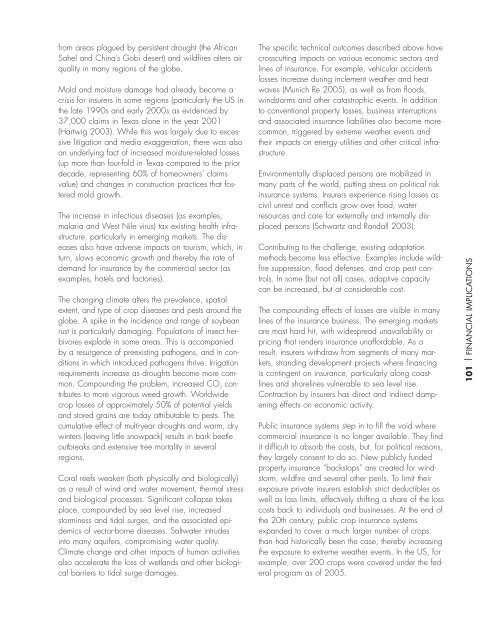Climate change futures: health, ecological and economic dimensions
Climate change futures: health, ecological and economic dimensions
Climate change futures: health, ecological and economic dimensions
You also want an ePaper? Increase the reach of your titles
YUMPU automatically turns print PDFs into web optimized ePapers that Google loves.
from areas plagued by persistent drought (the African<br />
Sahel <strong>and</strong> China’s Gobi desert) <strong>and</strong> wildfires alters air<br />
quality in many regions of the globe.<br />
Mold <strong>and</strong> moisture damage had already become a<br />
crisis for insurers in some regions (particularly the US in<br />
the late 1990s <strong>and</strong> early 2000s as evidenced by<br />
37,000 claims in Texas alone in the year 2001<br />
(Hartwig 2003). While this was largely due to excessive<br />
litigation <strong>and</strong> media exaggeration, there was also<br />
an underlying fact of increased moisture-related losses<br />
(up more than four-fold in Texas compared to the prior<br />
decade, representing 60% of homeowners’ claims<br />
value) <strong>and</strong> <strong>change</strong>s in construction practices that fostered<br />
mold growth.<br />
The increase in infectious diseases (as examples,<br />
malaria <strong>and</strong> West Nile virus) tax existing <strong>health</strong> infrastructure,<br />
particularly in emerging markets. The diseases<br />
also have adverse impacts on tourism, which, in<br />
turn, slows <strong>economic</strong> growth <strong>and</strong> thereby the rate of<br />
dem<strong>and</strong> for insurance by the commercial sector (as<br />
examples, hotels <strong>and</strong> factories).<br />
The changing climate alters the prevalence, spatial<br />
extent, <strong>and</strong> type of crop diseases <strong>and</strong> pests around the<br />
globe. A spike in the incidence <strong>and</strong> range of soybean<br />
rust is particularly damaging. Populations of insect herbivores<br />
explode in some areas. This is accompanied<br />
by a resurgence of preexisting pathogens, <strong>and</strong> in conditions<br />
in which introduced pathogens thrive. Irrigation<br />
requirements increase as droughts become more common.<br />
Compounding the problem, increased CO 2<br />
contributes<br />
to more vigorous weed growth. Worldwide<br />
crop losses of approximately 50% of potential yields<br />
<strong>and</strong> stored grains are today attributable to pests. The<br />
cumulative effect of multi-year droughts <strong>and</strong> warm, dry<br />
winters (leaving little snowpack) results in bark beetle<br />
outbreaks <strong>and</strong> extensive tree mortality in several<br />
regions.<br />
Coral reefs weaken (both physically <strong>and</strong> biologically)<br />
as a result of wind <strong>and</strong> water movement, thermal stress<br />
<strong>and</strong> biological processes. Significant collapse takes<br />
place, compounded by sea level rise, increased<br />
storminess <strong>and</strong> tidal surges, <strong>and</strong> the associated epidemics<br />
of vector-borne diseases. Saltwater intrudes<br />
into many aquifers, compromising water quality.<br />
<strong>Climate</strong> <strong>change</strong> <strong>and</strong> other impacts of human activities<br />
also accelerate the loss of wetl<strong>and</strong>s <strong>and</strong> other biological<br />
barriers to tidal surge damages.<br />
The specific technical outcomes described above have<br />
crosscutting impacts on various <strong>economic</strong> sectors <strong>and</strong><br />
lines of insurance. For example, vehicular accidents<br />
losses increase during inclement weather <strong>and</strong> heat<br />
waves (Munich Re 2005), as well as from floods,<br />
windstorms <strong>and</strong> other catastrophic events. In addition<br />
to conventional property losses, business interruptions<br />
<strong>and</strong> associated insurance liabilities also become more<br />
common, triggered by extreme weather events <strong>and</strong><br />
their impacts on energy utilities <strong>and</strong> other critical infrastructure.<br />
Environmentally displaced persons are mobilized in<br />
many parts of the world, putting stress on political risk<br />
insurance systems. Insurers experience rising losses as<br />
civil unrest <strong>and</strong> conflicts grow over food, water<br />
resources <strong>and</strong> care for externally <strong>and</strong> internally displaced<br />
persons (Schwartz <strong>and</strong> R<strong>and</strong>all 2003).<br />
Contributing to the challenge, existing adaptation<br />
methods become less effective. Examples include wildfire<br />
suppression, flood defenses, <strong>and</strong> crop pest controls.<br />
In some (but not all) cases, adaptive capacity<br />
can be increased, but at considerable cost.<br />
The compounding effects of losses are visible in many<br />
lines of the insurance business. The emerging markets<br />
are most hard hit, with widespread unavailability or<br />
pricing that renders insurance unaffordable. As a<br />
result, insurers withdraw from segments of many markets,<br />
str<strong>and</strong>ing development projects where financing<br />
is contingent on insurance, particularly along coastlines<br />
<strong>and</strong> shorelines vulnerable to sea level rise.<br />
Contraction by insurers has direct <strong>and</strong> indirect dampening<br />
effects on <strong>economic</strong> activity.<br />
Public insurance systems step in to fill the void where<br />
commercial insurance is no longer available. They find<br />
it difficult to absorb the costs, but, for political reasons,<br />
they largely consent to do so. New publicly funded<br />
property insurance “backstops” are created for windstorm,<br />
wildfire <strong>and</strong> several other perils. To limit their<br />
exposure private insurers establish strict deductibles as<br />
well as loss limits, effectively shifting a share of the loss<br />
costs back to individuals <strong>and</strong> businesses. At the end of<br />
the 20th century, public crop insurance systems<br />
exp<strong>and</strong>ed to cover a much larger number of crops<br />
than had historically been the case, thereby increasing<br />
the exposure to extreme weather events. In the US, for<br />
example, over 200 crops were covered under the federal<br />
program as of 2005.<br />
101 | FINANCIAL IMPLICATIONS

















